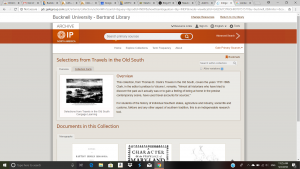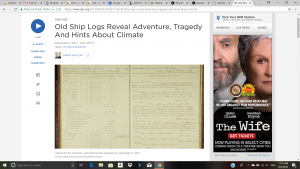In the Research Projects that were looked at like the, “Database of Indigenous People in North America,” had many interacting material that are displayed in our screen with a click of our mouse. With the new interactions of these archives conveys that our research practices are changing in order to be more visually pleasing to people and be more accessible to the public. In the Research Projects, the primary Digital Humanities focus was Archive in the site itself. With Archiving it allows people to see documents, letters and other images that can be easily accessed in the site, than having someone go to specific place just to see the physical copy once. However, there are disadvantages to that.
There are disadvantages when analyzing things in digital form because there is significance when looking at the object in first hand. It can show if the object is truly of significance or not to a specific area. No one can truly understand meaning of a place unless one goes to that specific place and talk to the people of that area or walk around that area in order to imagine how a person will live in this place.
With looking at the Research Projects in Archive it has its clear advantages with having more approaches to this like Maps. Maps help in looking at mapping areas that have impacted by events in American History, Southeast Asia, and many more. In the archive of “Database of Indigenous People in North America” it give examples of some of them having named locations where Natives of the Land use to settle and the territory that was assigned to them by the American Government. With the methods that were presented in this specific Research Project it can fit into a scholarly subject matter in understanding the History of the Indigenous people in a certain place and time. With having the perspectives of many people coming from newspapers, photographs, census and etc. it allows the average person connect the ideas of the past for them understand the actions of those people in the past. The determining factor that makes the digital representation to be conveyed to world is by the type material that is given and the amount information one has in their disposal to explain a subject matter. One has to determine in what ways can we share this information to a audience. Some people would just publish it into a book that can only be read in a physical copy. Or there are people who rather share to a public domain that is online to capture a larger audience. Another example can be an audio recording that was captured of very important event. One of the many ways people will be allowed to hear it is by either going to the object itself and get the permission to hear it, or having a copy online that can be easily accessed by one click.
The physical and emotional relationships to our objects of study are shifting in a digital age that can’t be stop. The reason is that is for efficiency. Lets say someone has found a huge discovery that can impact our world and the way to share it quickly is by using online tools that can be presented to a huge audience and can be analysed by other researches around the world. In a matter of time.
Digitized materials enhance the necessity of and desire for archival work because the physical location where that material came from can help us understand the meaning of that piece because a picture of a place can’t supplement the meaning of a place.


Mauricio Enrique Martínez is a student who is majoring in Cultural Anthropology and Japanese at Bucknell University. A wanderer in life.